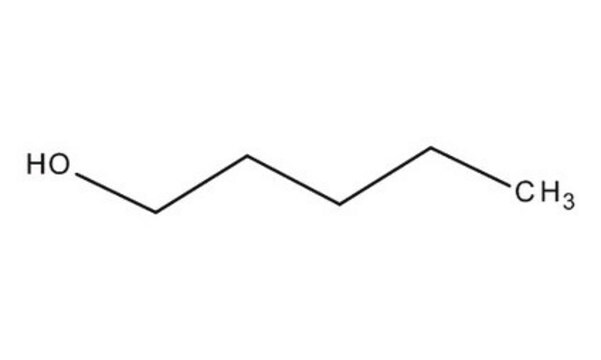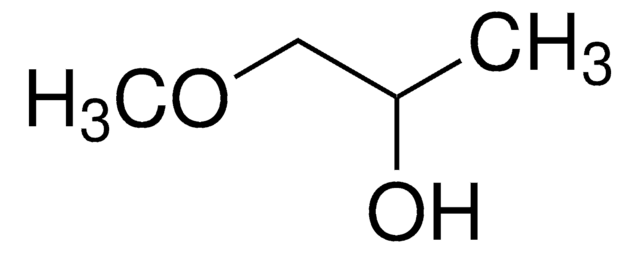W205605
1-Pentanol
≥99%, FG
Synonyme(s) :
1-Pentanol, n-Amyl alcohol, Pentyl alcohol
About This Item
Fragrance grade
meets purity specifications of JECFA
Produits recommandés
Source biologique
synthetic
Niveau de qualité
Qualité
FG
Fragrance grade
Agence
follows IFRA guidelines
meets purity specifications of JECFA
Conformité réglementaire
EU Regulation 1223/2009
EU Regulation 1334/2008 & 872/2012
FDA 21 CFR 172.515
FDA 21 CFR 176.180
FDA 21 CFR 176.210
Densité de vapeur
3 (vs air)
Pression de vapeur
1 mmHg ( 13.6 °C)
1.5 mmHg ( 20 °C)
Essai
≥99%
Forme
liquid
Température d'inflammation spontanée
572 °F
Limite d'explosivité
10 %, 100 °F
Indice de réfraction
n20/D 1.409 (lit.)
pb
136-138 °C (lit.)
Pf
−78 °C (lit.)
Densité
0.811 g/mL at 25 °C (lit.)
Application(s)
flavors and fragrances
Documentation
see Safety & Documentation for available documents
Allergène alimentaire
no known allergens
Allergène de parfum
no known allergens
Propriétés organoleptiques
pungent; chemical; wine-like
Chaîne SMILES
CCCCCO
InChI
1S/C5H12O/c1-2-3-4-5-6/h6H,2-5H2,1H3
Clé InChI
AMQJEAYHLZJPGS-UHFFFAOYSA-N
Vous recherchez des produits similaires ? Visite Guide de comparaison des produits
Description générale
Application
- Process-specified emission factors and characteristics of VOCs from the auto-repair painting industry.: This article evaluates the emission factors and characteristics of various volatile organic compounds, including amyl alcohol, in auto-repair painting, significant for environmental biochemistry and safety assessments (Xiao et al., 2024).
Mention d'avertissement
Danger
Mentions de danger
Classification des risques
Acute Tox. 4 Inhalation - Eye Dam. 1 - Flam. Liq. 3 - Skin Irrit. 2 - STOT SE 3
Organes cibles
Respiratory system
Code de la classe de stockage
3 - Flammable liquids
Classe de danger pour l'eau (WGK)
WGK 1
Point d'éclair (°F)
120.2 °F - closed cup
Point d'éclair (°C)
49 °C - closed cup
Équipement de protection individuelle
Eyeshields, Faceshields, Gloves, type ABEK (EN14387) respirator filter
Faites votre choix parmi les versions les plus récentes :
Déjà en possession de ce produit ?
Retrouvez la documentation relative aux produits que vous avez récemment achetés dans la Bibliothèque de documents.
Les clients ont également consulté
Notre équipe de scientifiques dispose d'une expérience dans tous les secteurs de la recherche, notamment en sciences de la vie, science des matériaux, synthèse chimique, chromatographie, analyse et dans de nombreux autres domaines..
Contacter notre Service technique













